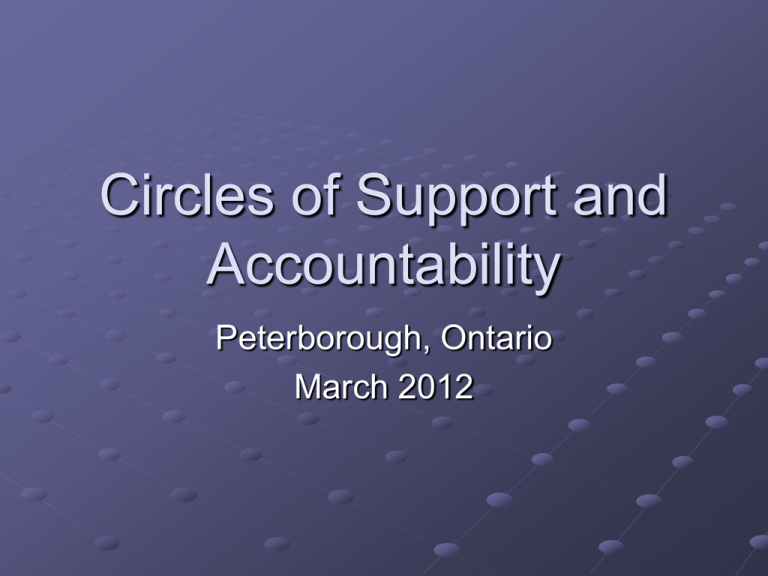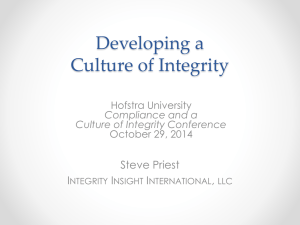
Circles of Support and
Accountability
Peterborough, Ontario
March 2012
Circles of Support and
Accountability
Part 1: The Model
Part 2: The Practicalities of “How To”
Circles of Support and Accountability
.
CoSA – The Model
Based on “wrap around care”
Late 1960s to 1970s: early precedents:
Originally Canadian (John Brown)
Brownsdale programs,
Kaleidoscope, Chicago (Karl Dennis)
1985: Alaska Youth Initiative or AYI (John
VanDenBerg)
Circles of Support and Accountability
.
Not a “Program”
Sheds a “service-driven” approach.
Wraparound is a process, not a service. It
is a collaborative strategic planning
process driven by identified needs of an
individual human person (i.e. not a
“population,” or “offender,” “sex offender,”
or “ex-offender.”
The individualized plans are strengthsbased and needs-driven.
Circles of Support and Accountability
.
Not a “Program”
Professionals must adopt a new way of
thinking in order to work successfully in a
wraparound model.
Collaboration and flexibility among service
providers are needed for this process to
work effectively.
For CoSA, professionalism gives way to
community-based processes.
Circles of Support and Accountability
.
Circles of Support and
Accountability
(CoSA)
Fundamentally
Two “Circles” Comprise CoSA
Circles of Support and Accountability
.
Two Circles of CoSA
The “Outer” Circle
Circles of Support and Accountability
.
Professional
The Outer Circle
Comprised of local, community-based
professionals
Offer support, guidance and mentoring
Act as a “Safety Net” for CoSA
Participate in Steering Committee,
Advisory Panels, Boards of Directors, etc.
Offer a means of Accountability for local
CoSA Project
Circles of Support and Accountability
.
Two Circles of CoSA
The “Inner” Circle
Core
Volunteer
Circles of Support and Accountability
.
The Inner Circle
Comprised of local community-based
volunteers
Often drawn from local faith community
Includes the Core Member (the former
offender)
Numbers ~ four to six volunteers (each
day of the week)
Is guided by a “Covenant” (more on this in a
moment)
Circles of Support and Accountability
.
Circles of Support and
Accountability in Canada
Voluntary
and
Community-Based
Core Member
Volunteer
Circles of Support and Accountability
.
Professional
Circles of Support and
Accountability in Canada
Co-ordinator
Voluntary
and
Community-Based
Core Member
Volunteer
Circles of Support and Accountability
.
Professional
Origins of CoSA
Canadian Law changed in the 1990’s to allow for the detention of
certain offenders past their Statutory Release Date and held until
the last day of their sentence if they are
1.
serving a sentence for an offence involving crimes
of violence or crimes against persons, and
2.
The commission of the offence caused the death of or serious
harm to another person and there are reasonable grounds to
believe that the offender is likely to commit another such
offence before the end of the sentence, or
3.
The offence was a sexual offence involving a child and there
are reasonable grounds to believe that the offender is likely to
commit another sexual offence involving a child before the end
of the sentence.
Circles of Support and Accountability
.
Origins of CoSA
In 1994, “Charlie” presented just such a
case. He had done it before and he was
expected to do it again – to young boys.
Child sex offenders against young boys –
especially repeat offenders -- are among
the most serious “types” of sex offenders
we know of.
“Charlie” was being released without any
formal supervision.
Circles of Support and Accountability
.
Origins of CoSA
Several people from the local community some from a local church congregation had been visiting “Charlie” in prison.
Some of them had been thinking about his
release and the concepts of “wrap around
care” used in mental health.
With the help of a local pastor, they
formed a group of experienced volunteers
(“Charlie’s Angels”).
Circles of Support and Accountability
.
Origins of CoSA
With the release of yet another high risk
offender (Wray Budreo), CSC and the
Mennonite Central Committee of Ontario
initiated a pilot project to test the CoSA
model.
CSC Chaplaincy was instrumental in
establishing this first pilot project.
Chaplaincy began providing “seed” money
for other such projects across the country.
Circles of Support and Accountability
.
The Evolution of the CoSA
Community in Canada
A CoSA “community” began to grow in
Canada.
Principles were articulated.
Volunteer preparation materials were
produced.
The first effort to collect empirical data was
initiated.
The first in a series of “gatherings” of the
fledgling CoSA community were held.
Circles of Support and Accountability
.
A CoSA “community” began to
grow in Canada and abroad
Nova Scotia
New Brunswick
Quebec
Ontario
Manitoba
Saskatchewan
Alberta
British Columbia
(1)
(1)
(3)
(4)
(1)
(2)
(2)
(1)
N = 15
Circles for ± 150 Core Members
(average ± 9 CMs each)
Circles of Support and Accountability
.
Each of these CoSA
projects are located in
major cities of each
Province, however they
provide CoSA in a wide
geographic area. Regina
covers SW Sask. Fraser
Valley and Vancouver
covers most of Southern
British Columbia. Toronto
covers South Central
Ontario.
A CoSA “community” began to
grow in Canada and abroad
In In 2001 The British Home Office inaugurated
a version of the Canadian model in Thames
Valley, beginning with 3 pilots. The Quaker
Community, working with MAPPA (Multi-Agency
Public Protection Arrangements), and the
Canadians have guided the project since
inception.
Projects now exist in Scotland, Ireland and
Wales.
Circles of Support and Accountability
.
A CoSA “community” began to
grow in Canada and abroad
In the last few years (i.e. since approx.
2005), the Americans have also worked
closely with the Canadians to build their
versions of CoSA.
Projects consulting with and receiving
direct training from the Canadians are
located in Colorado, Minnesota, Vermont,
Washington and California.
Circles of Support and Accountability
.
Principles were Articulated
We believe in the inherent value and
dignity of each and every human being
and that no human being is therefore
disposable.
We acknowledge the ongoing pain and
need for healing among victims of violent
crime including sexual abuse and sexual
assault -- No More Victims
Circles of Support and Accountability
.
Principles were Articulated
We affirm that the community bears a
responsibility for contributing to the safe
restoration and healing of victims as well as the
safe re-entry of released men and women to the
community.
We believe communities are capable of
disapproving crime and increasing safety for
their members when they are appropriately
engaged and their capacity to confront conflict is
increased through education, and through
information-sharing.
Circles of Support and Accountability
.
Principles were Articulated
We seek to recreate community with former
offenders in responsible, healthy, and life-giving
ways that include appropriate safety for
everyone.
We accept the challenge of a radical hospitality,
and of risks involved in sharing our lives with
one another in community in the service of love
and justice.
We agree that membership in a Circle of
Support and Accountability – whether one is a
Core Member or Community Member – is
voluntary.
Circles of Support and Accountability
.
Principles were Articulated
Relationships between volunteer members of the
community and former offenders (Core Members) are
based in a “Covenant” that is unique for each Core
Member and Circle according to the needs of the Core
Member and the local community.
While a Circle of Support and Accountability project is
independent, it seeks to function in partnership with
those other community organizations, whether public or
private, that are likewise devoted to public safety, law
enforcement, the functioning of the judiciary, community
corrections and public health.
Circles of Support and Accountability
.
Principles were Articulated
We maintain that each local, communitybased Circle of Support and Accountability
is ultimately responsible to its local
community (i.e. the citizens who make up
their local city, town, village or municipal
district).
Circles of Support and Accountability
.
Principles were Articulated
Each “Circle” in “CoSA” seeks to establish
a relationship with a Core Member based
on trust, reciprocity and above all,
friendship.
Friendship recognizes fellowship in the
human fold – my humanity is caught up in
your humanity – the concept of UBUNTU
Circles of Support and Accountability
.
UBUNTU
http://www.youtube.com/watch?feature=play
er_detailpage&v=l-RUPwl5edA
Circles of Support and Accountability
.
UBUNTU
“When I dehumanize you, I inexorably
dehumanize myself. The solitary human
being is a contradiction in terms and
therefore you seek to work for the
common good because your humanity
comes into its own in belonging.”
- Desmond Tutu, Archbishop Emeritus of Cape Town
Circles of Support and Accountability
.
Principles were Articulated
Compare the CoSA principles with those articulated by Andrews &
Bonta (2003):
The Principle of Risk
CoSA works with high risk sex offenders
using processes designed to enhance
safety through consultation and
collaboration, and sound governance;
.
Circles of Support and Accountability
.
Principles were Articulated
Compare the CoSA principles with those articulated by Andrews &
Bonta (2003):
The Principle of Need
CoSA works with sex offenders who
have some criminogenic needs that are
the same as and some that are different
than other types of offenders .
Circles of Support and Accountability
.
Criminogenic Needs?
• Significant .Social Influences
(Positive, Neutral, Negative)
• Relationship Stability
• Emotional ID with Children
• Hostility toward women
• General Social Rejection
• Lack of concern for others
• Impulsive
• Poor Problem Solving Skills
• Negative Emotionality
• Co-operation with
Supervision
•
•
•
•
Sex Drive
Sex Preoccupation
Sex as Coping
Deviant Sexual Preference
These factors are left for
professional sex offender
therapists to address (we can
refer).
Circles of Support and Accountability
.
Principles were Articulated
The Principle of Responsivity
CoSA meets the unique needs of each individual (No
one Is Disposable).
General Responsivity: whether or not volunteers are
carefully selected for, and trained in, the appropriate
skills. These skills include: empathy, warmth, respect,
interest, and non-blaming communication.
Specific Responsivity: adjusting our approach to .
meet the unique features of each client including each
client's learning style.
Circles of Support and Accountability
.
QUESTION:
How do community volunteers not specifically
trained as therapists do this?
ANSWER:
Social Learning Theory: volunteers model
acceptable behaviour and disapprove
unacceptable behaviour.
Circles of Support and Accountability
.
Protective Factors
These are factors that “protect” against
criminal behaviour
and criminal reoffending
Being involved in community is a powerful
protective factor (the Circle is a returning
person’s first encounter with community).
Circles of Support and Accountability
.
Protective Factors
“ . . .it is generally accepted that social
relations and their quality . . . have a
stabilizing effect, especially after release.”
- Estroff, Zimmer,Lachicotte, & Benoit, 1994.
The influence of social networks
and social support on violence
- see also Albrecht, 1979
Circles of Support and Accountability
.
Protective Factors
Close supporting relationships were found
to decrease the risk of relapse in child
molesters and in rapists.
- Grubin, D. (1997). Predictors of risk in serious sex
offenders. British Journal of Psychiatry, 170(Suppl.),
17-21.
- see also Berner & Bolterauer,1995;
Circles of Support and Accountability
.
Protective Factors
Violent sexual reoffence is related to the
extent and quality of positive prosocial
support, particularly by male associates.
- Violent Sex Offenders Lack Male
Social Support.
Gutiérrez-Lobos , et al (2001). International
Journal of Offender Therapy and
Comparative Criminology, 45(1), 70-82
Circles of Support and Accountability
.
The first empirical data was
collected and analyzed
Circles of Support and Accountability
.
National Replication
_______________________________________________________________________________________
Circles (60) Control (60)
_______________________________________________________________________________________
M(SD) age
M(SD) STATIC-99
M(SD) RRASOR*
M(range–mos) follow-up
M(mos) until 1st failure
Recidivism
Sexual
Expected sexual
Violent*
General ‡
Dispositions
43.18 (9.55)
5.00 (2.14)
2.72 (1.50)
32.53 (6-84)
23.92
43.52 (8.66)
6.11 (1.52)
2.74 (1.36)
35.74 (6-95)
50.73
2.13% (1)
28.50% (17)**
8.51% (4)
10.64% (5)
17
12.77% (6)
26.45% (16)
31.91% (15)
38.30% (18)
75
_______________________________________________________________________________________
* p < .05 ** p < .01
‡
p < .10
Circles of Support and Accountability
.
The first in a series of gatherings of
the community were held
Inaugural Meeting at Crieff Hills 1998
Paris, Ontario 1999
Ancaster, Ontario 2002
Calgary, Alberta, 2008
Pierrefonds, Quebec, 2010
Victoria, BC (2010)
Ottawa, Ont. November , 2011
Circles of Support and Accountability
.
CoSA Roots in Faith Communities
Original group comprised of faith
community volunteers from M2W2 (a longstanding prison visitation program)
No One is Disposable principle is a faithbased tradition
The notion of “radical hospitality”
Circles of Support and Accountability
.
Radical Hospitality
People of a Christian faith respond to the gospel
message by welcoming the stranger (even an enemy)
into their midst.
Practicing radical hospitality means listening to others
without judgment and extending compassion that opens
up possibilities of seeing The Divine in other people.
Extending ourselves for the sake of others invites us to
grow – to experience those who are different from us
and perhaps learn to see new perspectives through the
lens of another person. . . to see a larger world that
extends beyond our comfort zones.
Circles of Support and Accountability
.
Practically Speaking . . .
Building a CoSA
A Local Community’s Experience
Circles of Support and Accountability
.
National Demonstration Project
In discussions with NCPC, CCJC, MCC Canada and
CSC.
Single CoSA project with multi-site design
Expected N = 100-150 Core Members annually
Empirical data to date: only on WED Sex Offenders
Demonstration Project to define exactly what works in
CoSA and why – what does not and why not.
CCJC is contrcting wiith The Saskatchewan Justice
Institute to do a Process and Impact Evaluation of CoSA.
Circles of Support and Accountability
.
Commonalities between CoSA
Sites in Canada
Basic Documentation practices (for safety
and accountability);
Safety and Risk Recognition;
Support, Accountability and
Confidentiality;
Volunteer Training;
Life Cycle of a Circle;
Circles of Support and Accountability
.
Summary
CoSA in Canada and abroad is well-established
and growing as a community.
As the network develops, new locations will
likely come on-stream.
As part of their “outer circle,” these new projects
will include linkages to the established
community. Going it alone is not an option if the
goal is public safety, no more victims, and core
members living safe, productive, peaceful lives
in community. Living in community is a skill that
we model.
Circles of Support and Accountability
.
National Communications
Protocol
To provide a formal and legally
established protocol for communicating
between CSC and CoSA Sites regarding
potential core members, offence history
and pertinent information regarding risk,
needs and responsivity.
Circles of Support and Accountability
.
National CoSA Association
National Website
www.cosacanada.com
Circles of Support and Accountability
.
National Contact Information
Rev. Rick Burk – Director General Chaplaincy and
Restorative Justice, Correctional Service
Canada BurkRG@CSC-SCC.GC.CA
Andrew McWhinnie –National Advisor to Associate
Director General Chaplaincy and Restorative
Justice, Correctional Service Canada.
1250-881-1151
250-889-2321
Andrew_McWhinnie@telus.net
Circles of Support and Accountability
.
Circles of Support and Accountability
.









